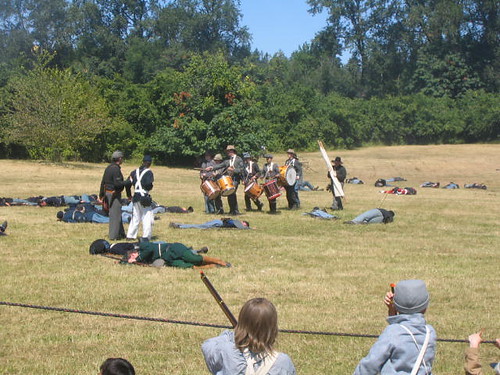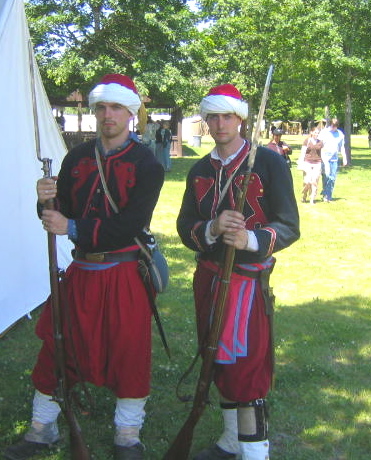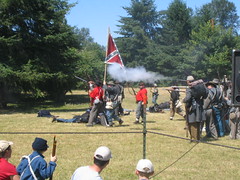We Done Whupped the Yankees!
OK. How bad is this? B and I went to a Civil War reenactment yesterday and—though I know that the South won—I never did find out which battle it was we were watching. That’s because I was so busy keeping an eye out for inaccuracies and anachronisms and trying to figure out just what this whole reenactment phenonmenon is about.
I’ve been fascinated by Civil War reenactments ever since I first heard about them. Apparently, there are two camps. The “button pissers,” the guys who are so maniacal about authenticity that they piss on the buttons of their uniforms to make them look suitably antique, and the “farbs,” the guys who think it’s perfectly OK to wear aviator sunglasses and hide a cooler full of Diet Pepsi behind a tree.
So there they were out on a big open field, scurrying about in their wool uniforms. And I do mean “scurrying.” There were some cavalry battalions but most of them were infantry and they’d emerge from behind a tree and scurry into position opposite another battalion. A guy with a bugle would rally them to action, an officer with a sword would slash at the air, and the battalions would take aim and fire at each other. It was all fairly primitive and chaotic--wars aren't fought this way anymore. I saw several very melodramatic “deaths,” involving much backward staggering that delayed the final keelover until the guy was in the shade of a large tree. Most of the "fatalities," however, were not within staggering distance of a tree, so their “corpses” baked in the brutal sun until the battle was over (20 minutes or so later) and they could get up and walk away.

The biggest surprise for me was that all the uniforms were different. An authentic detail, apparently. I might be wrong about this, but I think volunteer regiments (of which there were many) wore whatever the heck uniform they fancied. There were guys in plaid trousers, guys in green, in red, and in white. And there were these dashing and exotic fellows.

I saw them wandering about eating some watermelon after the battle, and I flagged them down to interrogate them about their uniforms. They were delighted to fill me in—after we moved into the shade. They had adopted the uniform of the 5th New York Volunteer Infantry, known as the Zouaves. The Zouaves were originally a North African tribe known for their fierceness. During the 19th century, French and American soldiers began copying their style of dress. Anyway, a number of these American Zouaves fought in the Civil War (mostly on the Union side). I don’t know how fierce they really were, but their uniform sure kicked ass. If you’re interested in this sort of thing, read more about the Zouaves here or here.
After the battle, we strolled around the encampments. I admit it--I was totally on the lookout for evidence of inauthenticity. Wristwatch—demerit! Basket of bananas—demerit! Factory-manufactured cigarette—demerit! Plastic water bottle—double demerits! Use a canteen, son!
Minor infractions, really, though. For the most part, I’d say the reenactors in the Northwest Civil War Council are pretty button pisserish. True, there were women fighting in the regiments (very inauthentic!), but I can’t fault them for that. If I were into Civil War reenactment, I’d much rather be out there on the battlefield than druding away washing dishes, dressed in a hoop skirt, a restrictive corset, and who knows how many layers of petticoats. I did see quite a number of women who are evidently into spending their vacations keeping a tent tidy. The tents were quite amazingly well appointed, too! I don’t know why I didn’t take any pictures of the tents and all they contained. Some of them had more furniture in them than I have in my house.
Most of them had cast-iron stoves and many had large tables with a full complement of chairs. Some had full-size beds covered in beautiful handmade quilts. That is a lot of stuff to schlep to an encampment and set up. It’s all made out of wood or iron, too, so it’s heavy and unwieldy. And then there were the china dishes; the cast-iron pots, pans, and utensils; dish racks and laundry racks. And big bundles of wood for the cooking fire.
All this got me to thinking. After a while I really had to wonder if all this obsessive attention to period detail only ensured that the reenactors got themselves farther and farther from having a truly “authentic” experience. I think for a lot of them they just tried to re-create their current lifestyle and standard of living using period-appropriate products. Paper plates aren’t authentic? OK. I’ll bring a full set of china dishes. Packaged cookies aren’t authentic? OK. I’ll bake some cookies beforehand and carry them to the encampment in a big, heavy glass jar. Sleeping bags aren’t authentic? OK. I’ll bring a handcrafted bed and a handmade quilt.
The majority of real Civil War soldiers probably slept on the ground in filthy, torn blankets and counted themselves lucky if they got a couple of maggot-infested biscuits to eat. Every single soldier would not have had his own stove. Nor would he have had a supply of watermelons and cookies. Back in the 1860s people couldn't drive SUVs from battle to battle. They had horses, but it would have been absurd to load them down with frivolities and luxuries when they needed to haul ammunition and battlefield supplies.
So whatever it is that the reenactors are going for it’s not true authenticity. True authenticity would involve discomfort, deprivation, and death. Lots and lots of death--didn't the Civil War have more casualties than any other war ever? I’m not judging, but after a while it did strike me that what I was observing was a very modern phenomenon. Even 50 years ago, especially in the South, I’m sure people would have been outraged at the idea of trying to re-create such a painful era in American history—for entertainment.
I’m sure there are still people who feel that way, and I can totally understand their point of view. On the other hand, maybe these reenactments serve some purpose, but my impression is that it's just an opportunity to dress up and pretend (especially for the “civilians” who don't participate in the battles). There seems to be a fundamental disconnect. I wonder how many of them think about what it must have really been like to be in the path of one of Sherman's scorched earth campaigns. For starters, they'd better forget about all that watermelon.
Wow. The tone of this blog entry has certainly taken a turn. I don’t know what I’m going on about, really. I guess I’m just grappling with exactly what makes Civil War reenactors go to all the trouble of trying to replicate with painstaking accuracy (but not really) a moment in history. Hey, maybe I should have asked them! I know they would have been more than happy to answer any questions I might pose. ("So do you piss on your buttons?")
Seriously, that’s really why I went—not to see the battle but to see the people and to try to work out what it is that drew them to this hobby (or whatever it is) in the first place. It was foolish of me to think that I’d be able to suss that out without actually talking to them (this, by the way, is a mistake I make in all areas of my life, as I am forever trying to figure out stuff without having to approach strangers and ask for some of their precious time). And I had my chance, too, I somehow mustered the gumption to buttonhole those two Zouave dudes, but all I did was ask them about their uniforms. I have no insight into what made them “join up” or even why they chose to be Zouaves. And what made them choose to be Union soldiers instead of Confederate soldiers? Was there more to it than the chance to wear a turban and some billowing trousers? Now I’ll never know.
I’ve been fascinated by Civil War reenactments ever since I first heard about them. Apparently, there are two camps. The “button pissers,” the guys who are so maniacal about authenticity that they piss on the buttons of their uniforms to make them look suitably antique, and the “farbs,” the guys who think it’s perfectly OK to wear aviator sunglasses and hide a cooler full of Diet Pepsi behind a tree.
So there they were out on a big open field, scurrying about in their wool uniforms. And I do mean “scurrying.” There were some cavalry battalions but most of them were infantry and they’d emerge from behind a tree and scurry into position opposite another battalion. A guy with a bugle would rally them to action, an officer with a sword would slash at the air, and the battalions would take aim and fire at each other. It was all fairly primitive and chaotic--wars aren't fought this way anymore. I saw several very melodramatic “deaths,” involving much backward staggering that delayed the final keelover until the guy was in the shade of a large tree. Most of the "fatalities," however, were not within staggering distance of a tree, so their “corpses” baked in the brutal sun until the battle was over (20 minutes or so later) and they could get up and walk away.

The biggest surprise for me was that all the uniforms were different. An authentic detail, apparently. I might be wrong about this, but I think volunteer regiments (of which there were many) wore whatever the heck uniform they fancied. There were guys in plaid trousers, guys in green, in red, and in white. And there were these dashing and exotic fellows.

I saw them wandering about eating some watermelon after the battle, and I flagged them down to interrogate them about their uniforms. They were delighted to fill me in—after we moved into the shade. They had adopted the uniform of the 5th New York Volunteer Infantry, known as the Zouaves. The Zouaves were originally a North African tribe known for their fierceness. During the 19th century, French and American soldiers began copying their style of dress. Anyway, a number of these American Zouaves fought in the Civil War (mostly on the Union side). I don’t know how fierce they really were, but their uniform sure kicked ass. If you’re interested in this sort of thing, read more about the Zouaves here or here.
After the battle, we strolled around the encampments. I admit it--I was totally on the lookout for evidence of inauthenticity. Wristwatch—demerit! Basket of bananas—demerit! Factory-manufactured cigarette—demerit! Plastic water bottle—double demerits! Use a canteen, son!
Minor infractions, really, though. For the most part, I’d say the reenactors in the Northwest Civil War Council are pretty button pisserish. True, there were women fighting in the regiments (very inauthentic!), but I can’t fault them for that. If I were into Civil War reenactment, I’d much rather be out there on the battlefield than druding away washing dishes, dressed in a hoop skirt, a restrictive corset, and who knows how many layers of petticoats. I did see quite a number of women who are evidently into spending their vacations keeping a tent tidy. The tents were quite amazingly well appointed, too! I don’t know why I didn’t take any pictures of the tents and all they contained. Some of them had more furniture in them than I have in my house.
Most of them had cast-iron stoves and many had large tables with a full complement of chairs. Some had full-size beds covered in beautiful handmade quilts. That is a lot of stuff to schlep to an encampment and set up. It’s all made out of wood or iron, too, so it’s heavy and unwieldy. And then there were the china dishes; the cast-iron pots, pans, and utensils; dish racks and laundry racks. And big bundles of wood for the cooking fire.
All this got me to thinking. After a while I really had to wonder if all this obsessive attention to period detail only ensured that the reenactors got themselves farther and farther from having a truly “authentic” experience. I think for a lot of them they just tried to re-create their current lifestyle and standard of living using period-appropriate products. Paper plates aren’t authentic? OK. I’ll bring a full set of china dishes. Packaged cookies aren’t authentic? OK. I’ll bake some cookies beforehand and carry them to the encampment in a big, heavy glass jar. Sleeping bags aren’t authentic? OK. I’ll bring a handcrafted bed and a handmade quilt.
The majority of real Civil War soldiers probably slept on the ground in filthy, torn blankets and counted themselves lucky if they got a couple of maggot-infested biscuits to eat. Every single soldier would not have had his own stove. Nor would he have had a supply of watermelons and cookies. Back in the 1860s people couldn't drive SUVs from battle to battle. They had horses, but it would have been absurd to load them down with frivolities and luxuries when they needed to haul ammunition and battlefield supplies.
So whatever it is that the reenactors are going for it’s not true authenticity. True authenticity would involve discomfort, deprivation, and death. Lots and lots of death--didn't the Civil War have more casualties than any other war ever? I’m not judging, but after a while it did strike me that what I was observing was a very modern phenomenon. Even 50 years ago, especially in the South, I’m sure people would have been outraged at the idea of trying to re-create such a painful era in American history—for entertainment.
I’m sure there are still people who feel that way, and I can totally understand their point of view. On the other hand, maybe these reenactments serve some purpose, but my impression is that it's just an opportunity to dress up and pretend (especially for the “civilians” who don't participate in the battles). There seems to be a fundamental disconnect. I wonder how many of them think about what it must have really been like to be in the path of one of Sherman's scorched earth campaigns. For starters, they'd better forget about all that watermelon.
Wow. The tone of this blog entry has certainly taken a turn. I don’t know what I’m going on about, really. I guess I’m just grappling with exactly what makes Civil War reenactors go to all the trouble of trying to replicate with painstaking accuracy (but not really) a moment in history. Hey, maybe I should have asked them! I know they would have been more than happy to answer any questions I might pose. ("So do you piss on your buttons?")
Seriously, that’s really why I went—not to see the battle but to see the people and to try to work out what it is that drew them to this hobby (or whatever it is) in the first place. It was foolish of me to think that I’d be able to suss that out without actually talking to them (this, by the way, is a mistake I make in all areas of my life, as I am forever trying to figure out stuff without having to approach strangers and ask for some of their precious time). And I had my chance, too, I somehow mustered the gumption to buttonhole those two Zouave dudes, but all I did was ask them about their uniforms. I have no insight into what made them “join up” or even why they chose to be Zouaves. And what made them choose to be Union soldiers instead of Confederate soldiers? Was there more to it than the chance to wear a turban and some billowing trousers? Now I’ll never know.




0 Comments:
Post a Comment
<< Home